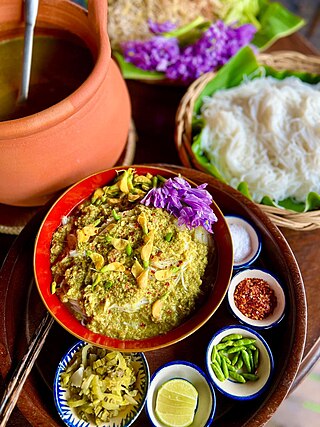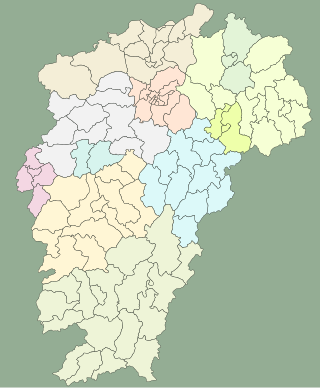| Hubei cuisine | |||||||
|---|---|---|---|---|---|---|---|
| Chinese | 湖北菜 | ||||||
| |||||||
| Chu cuisine | |||||||
| Chinese | 楚菜 | ||||||
| |||||||
| Part of a series on |
| Chinese cuisine |
|---|
 |
Hubei cuisine, also known as Chu cuisine or E cuisine, is derived from the native cooking styles of Hubei Province in China.
| Hubei cuisine | |||||||
|---|---|---|---|---|---|---|---|
| Chinese | 湖北菜 | ||||||
| |||||||
| Chu cuisine | |||||||
| Chinese | 楚菜 | ||||||
| |||||||
| Part of a series on |
| Chinese cuisine |
|---|
 |
Hubei cuisine, also known as Chu cuisine or E cuisine, is derived from the native cooking styles of Hubei Province in China.
Hubei cuisine has a history of more than 2,000 years. The names of dishes and cuisine styles can be found in ancient literature such as Chuci of Qu Yuan.
As Hubei has plenty of lakes, rivers and marshlands, freshwater produce are used as major ingredients in the local cuisine. A key ingredient that is found within many Hubei-style dishes is the lotus root. [1]
Hubei cuisine emphasizes the preparation of ingredients and the matching of colors. It specializes in steaming techniques. Its style is influenced by the cooking methods of the cuisines of neighboring provinces such as Sichuan and Hunan. As a result, Hubei cuisine also uses dried hot pepper, black pepper and other spices to enhance the flavor of dishes.
Hubei cuisine comprises four distinct styles:
| English | Traditional Chinese | Simplified Chinese | Pinyin | Notes |
|---|---|---|---|---|
| Three-Delicacy Dried Bean Curd Sheet | 三鮮豆皮 | 三鲜豆皮 | sān xiān dòu pí | |
| Hot Dry Noodles | 熱乾麵 | 热干面 | rè gān miàn | |
| Fish Cakes and Ball | 魚糕丸子 | 鱼糕丸子 | yú gāo wán zi | |
| Mianyang Three Kinds of Steamed Food | 沔陽三蒸 | 沔阳三蒸 | miǎn yáng sān zhēng | |

Cantonese or Guangdong cuisine, also known as Yue cuisine, is the cuisine of Guangdong province of China, particularly the provincial capital Guangzhou, and the surrounding regions in the Pearl River Delta including Hong Kong and Macau. Strictly speaking, Cantonese cuisine is the cuisine of Guangzhou or of Cantonese speakers, but it often includes the cooking styles of all the speakers of Yue Chinese languages in Guangdong.

Shanghai cuisine, also known as Hu cuisine, is a popular style of Chinese food. In a narrow sense, Shanghai cuisine refers only to what is traditionally called Benbang cuisine which originated in Shanghai. In a broader sense, it refers to complex styles of cooking developed under the influence of neighboring Jiangsu and Zhejiang provinces.

Thai cuisine is the national cuisine of Thailand.

Vietnamese cuisine encompasses the foods and beverages of Vietnam. Meals feature a combination of five fundamental tastes : sweet, salty, bitter, sour, and spicy. The distinctive nature of each dish reflects one or more elements, which are also based around a five-pronged philosophy. Vietnamese recipes use ingredients like lemongrass, ginger, mint, Vietnamese mint, long coriander, Saigon cinnamon, bird's eye chili, lime, and Thai basil leaves. Traditional Vietnamese cooking has often been characterised as using fresh ingredients, not using much dairy or oil, having interesting textures, and making use of herbs and vegetables. The cuisine is also low in sugar and is almost always naturally gluten-free, as many of the dishes are rice-based instead of wheat-based, made with rice noodles, papers and flour. Vietnamese cuisine is strongly influenced not only by the cuisines of neighboring China, Cambodia and Laos, but also by French cuisine due to French colonial rule over the region from 1887 to 1954.

Malaysian cuisine consists of cooking traditions and practices found in Malaysia, and reflects the multi-ethnic makeup of its population. The vast majority of Malaysia's population can roughly be divided among three major ethnic groups: Malays, Chinese and Indians. The remainder consists of the indigenous peoples of Sabah and Sarawak in East Malaysia, the Orang Asli of Peninsular Malaysia, the Peranakan and Eurasian creole communities, as well as a significant number of foreign workers and expatriates.

Indonesian cuisine is a collection of various regional culinary traditions that formed in the archipelagic nation of Indonesia. There are a wide variety of recipes and cuisines in part because Indonesia is composed of approximately 6,000 populated islands of the total 17,508 in the world's largest archipelago, with more than 1,300 ethnic groups.

Malay cuisine is the traditional food of the ethnic Malays of Southeast Asia, residing in modern-day Malaysia, Indonesia, Singapore, Brunei, Southern Thailand and the Philippines as well as Cocos Islands, Christmas Island, Sri Lanka and South Africa.

Cambodian cuisine combines the culinary traditions of many different ethnic groups in Cambodia, an important subset of which is Khmer cuisine, the nearly-two-thousand-year-old culinary tradition of the majority Khmer people. Over centuries, Cambodian cuisine has incorporated elements of Indian, Chinese, Portuguese and French cuisine, and due to some of these shared influences and mutual interaction, it has many similarities with the cuisines of Central Thailand, and Southern Vietnam and to a lesser extent also Central Vietnam, Northeastern Thailand and Laos.

Korean royal court cuisine was the style of cookery within Korean cuisine traditionally consumed at the court of the Joseon Dynasty, which ruled Korea from 1392 to 1910. There has been a revival of this cookery style in the 21st century. It is said that twelve dishes should be served along with rice and soup, with most dishes served in bangjja (bronzeware).

Pancit, also spelled pansít, is a general term referring to various traditional noodle dishes in Filipino cuisine. There are numerous types of pancit, often named based on the noodles used, method of cooking, place of origin, equal and constant diameter or the ingredients. Most pancit dishes are characteristically served with calamansi, which adds a citrusy flavor profile.

Chinese Indonesian cuisine is characterized by the mixture of Chinese with local Indonesian style. Chinese Indonesians, mostly descendant of Han ethnic Hokkien and Hakka speakers, brought their legacy of Chinese cuisine, and modified some of the dishes with the addition of Indonesian ingredients, such as kecap manis, palm sugar, peanut sauce, chili, santan and local spices to form a hybrid Chinese-Indonesian cuisine. Some of the dishes and cakes share the same style as in Malaysia and Singapore, known as Nyonya cuisine by the Peranakan.

Peranakan cuisine or Nyonya cuisine comes from the Peranakans, descendants of early Chinese migrants who settled in Penang, Malacca, Singapore and Indonesia, inter-marrying with local Malays. In Baba Malay, a female Peranakan is known as a nonya, and a male Peranakan is known as a baba. The cuisine combines Chinese, Malay, Javanese, South Indian, and other influences.

Jiangxi cuisine, also known as Gan cuisine, is a style of Chinese cuisine derived from the native cooking styles of Jiangxi province in southern China. According to the East China Travel Guide published in 1983, Jiangxi Cuisine has its unique taste which can be described in four Chinese idioms: 原汁原味(aim to bring out the own flavor of the cooking material),油厚不腻(dishes contained a significant amount of oil but the taste are not greasy),口味浓厚(dishes have really thick taste),咸鲜兼辣(always come with spicy solid, salty flavor). Jiangxi cuisine is widely popular within the ordinary family because most of the notable dishes from Jiangxi cuisine are the extension of homely dishes with solid local flavor.

Thai curry is a dish in Thai cuisine made from curry paste, coconut milk or water, meat, seafood, vegetables or fruit, and herbs. Curries in Thailand mainly differ from the curries in India in their use of ingredients such as herbs and aromatic leaves over a mix of spices.

Javanese cuisine is the cuisine of Javanese people, a major ethnic group in Indonesia, more precisely the province of Central Java, Yogyakarta and East Java.

Sundanese cuisine is the cuisine of the Sundanese people of Western Java, and Banten, Indonesia. It is one of the most popular foods in Indonesia. Sundanese food is characterised by its freshness; the famous lalab eaten with sambal and also karedok demonstrate the Sundanese fondness for fresh raw vegetables. Unlike the rich and spicy taste, infused with coconut milk and curry of Minangkabau cuisine, the Sundanese cuisine displays the simple and clear taste; ranged from savoury salty, fresh sourness, mild sweetness, to hot and spicy.

Chinese regional cuisines are amongst the many different cuisines found in different provinces and prefectures of China as well as from larger overseas Chinese communities.